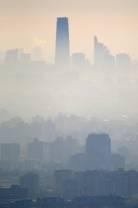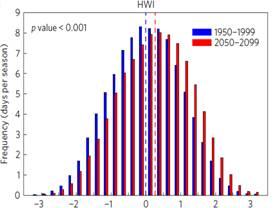
Recently, the "Nature Climate Change" journal published the paper "Weather conditions conductive to Beijing severe haze more frequent under climate change" online, whose corresponding author is Professor Liao Hong of our university. The first author of the paper is Prof. Cai Wenju, an expert of the "Thousand Talents Program" of China Ocean University, also in the Qingdao National Ocean Laboratory, and other collaborators include Li Ke, doctoral student of Institute of Atmospheric Physics, Chinese Academy of Sciences, Academician Wang Huijun of our university, and Academician Wu Lixin, China Ocean University. This paper was selected by the journal Nature Climate Change as a cover paper published in April 2017, and at the corresponding period, a commentary was published on the paper, written by Academician Zhang Renhe, Fudan University. Impact Factor of "Nature Climate Change" in 2015 is 17.18.
The study focused on Beijing's haze pollution event (about PM2.5 concentration greater than 150 micrograms / cubic meter). Combining PM2.5 concentration observed and the Coupled Model Intercomparison Project Phase 5 (CMIP5) for 15 climate models’ daily Simulation, they found that global warming caused by greenhouse gases increased the quiet weather in the North China Plain, thereby increasing the frequency and duration of winter haze events.
This research took advantage of meteorological data which observed for seven years about the concentration of PM2.5 day by day in winter and the reanalyzed the meteorological data, and defined Haze Weather Index which expressed by atmospheric meridional wind velocity, vertical temperature gradient and middle and upper zonal circulation by synthesis analyzing statistical relationship between strong haze event and Large scale circulation background. The research showed that the air condition which took advantage of the formation of strong haze event had raised 10 percent during 1982 to 2015 comparing with 1948 to 1981. The research also analyzed historical climate (1950-1999) simulated daily by CIMP5 multi-mode and the frequency that HWI will happen under the climate of RCP8.5 in the future, observing that the rate of arising strong haze pollution which similar to the pollution happened in January, 2013 will increase 50 percent comparing historical climate condition. In the context of global warming, the lower atmosphere is more stable because the Arctic oscillation is enhanced, Winter East Asian monsoon is weaken, East Asia major trough became shallow and surface atmospheric warming quickly, all these factors leads to the increase of strong haze event.
Studies show that incremental formidable weather condition makes it more difficult to take measures against pollution in North China plain. Reducing pollution discharge is far more enough to control the serious haze pollution in North China. What’s more, GHG emissions mitigation needs carrying out on a global scale to slow down global warming.
This research has been funded by 973 Program (2014CB441202) and NFSC Dust-haze Key Research Projects (91544219).
The left vignette: Severe reduction of atmospheric visibility at the event of serious haze event
The right vignette: In the future of multi-code imitation (2050-2099), on the premise of maximum discharge of greenhouse gases (RCP8.5), HWI markedly increased compared to the past.
Please see the commentary essay in“News and views”:http://dx.doi.org/10.1038/nclimate3257



